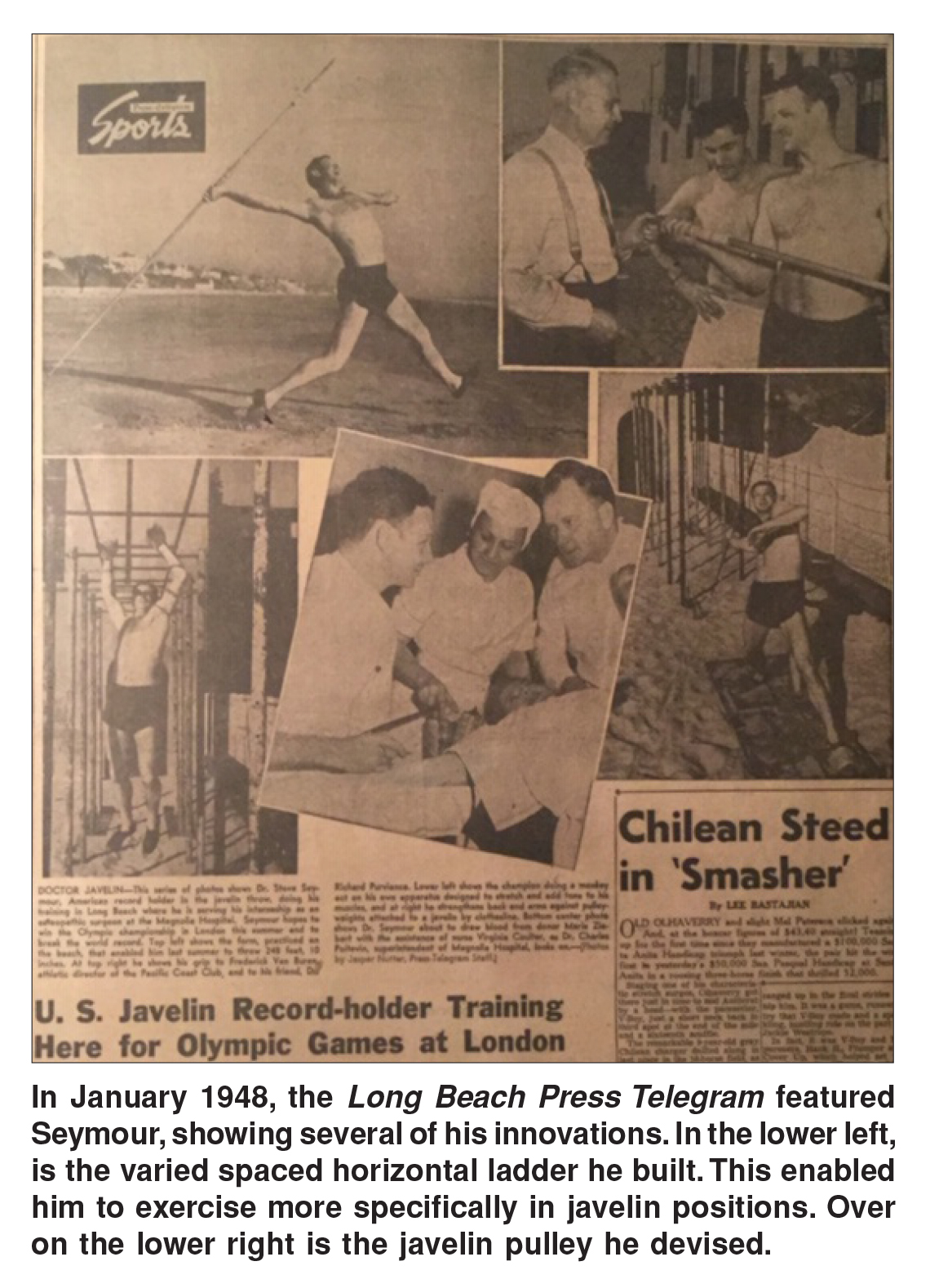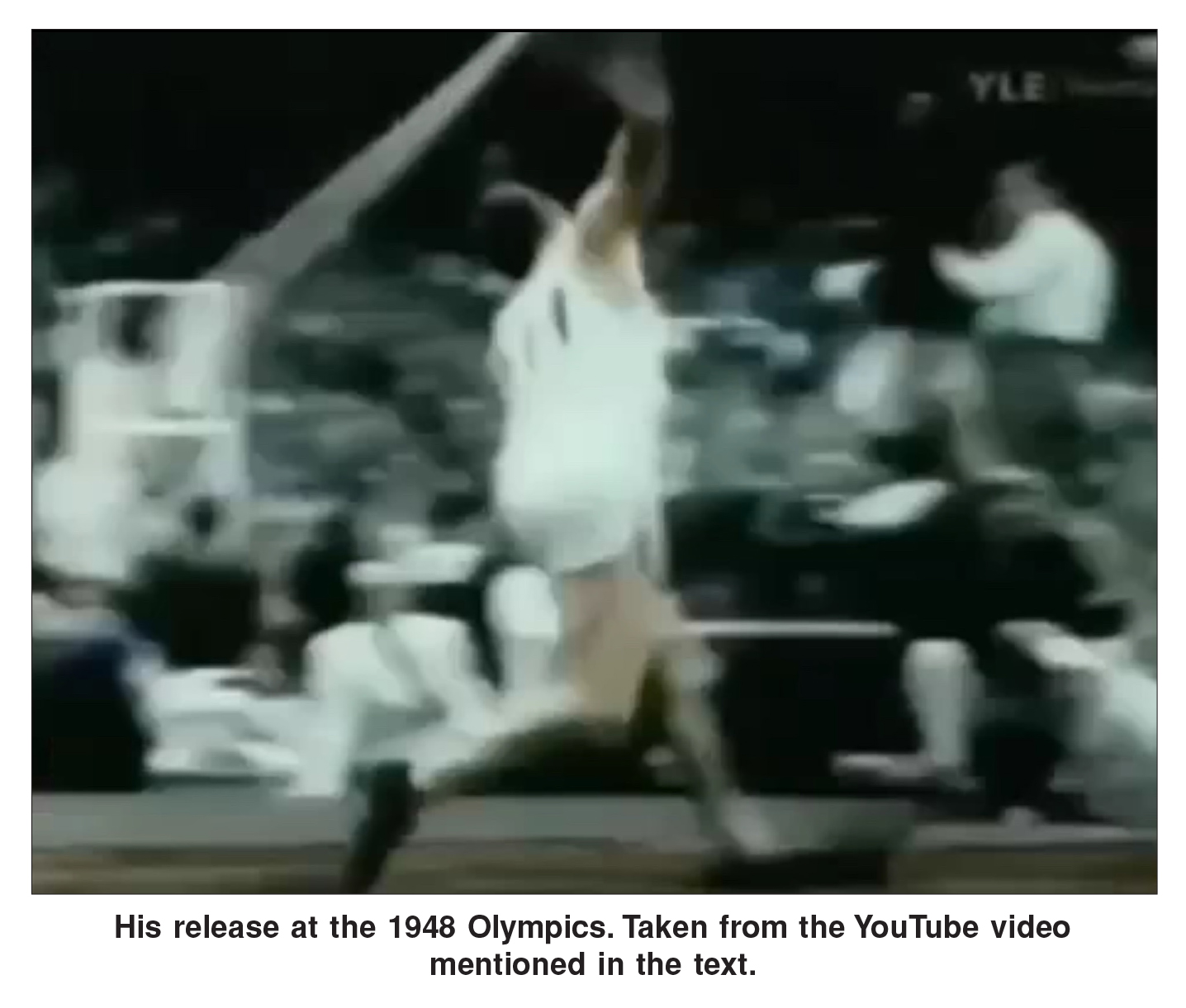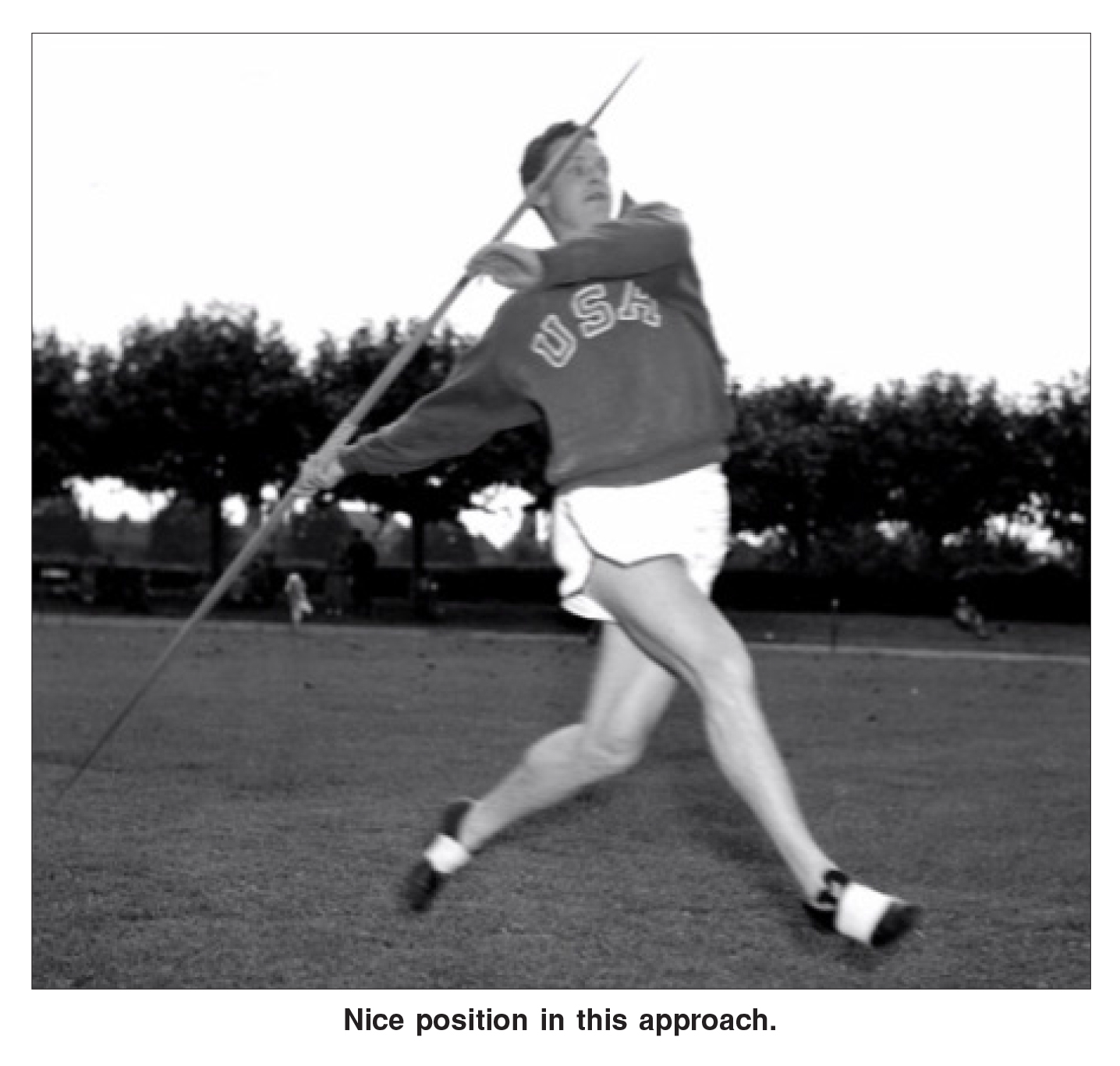Kevin McGill, who wrote the Javelin and Hammer chapters in The Throws Manual, a 1991 publication from Tafnews Press, and updated the subsequent editions of the book, is a lifelong afidonado of javelin throwing. Here he assembles a fascinating remembrance of one of the true pioneers of American javelin throwing, 1948 Olympic silver medalist Steve Seymour.
By Kevin McGill
In Sports Illustrated, July, 1969, Jerry Kirshenbaum interviewed several javelin throwers for a piece entitled “They’re All Out to Launch.” He had a quote, which I ran across in a piece by Klaus Bartonietz in February 2019. It has also been in Bob Sing’s book, The Dynamics of the Javelin Throw, and somehow, in concentrating on the other sections, I missed it in the 1980’s, a second time. Here it is.
“One mustn’t think of th
e javelin as a minor sport like curling or anything. The javelin represents the glory of Greece and it symbolizes man’s search for his primitive ancestral identity. I can blink my eyes and look out at a javelin thrower and see tens of thousands of warriors marching across the field and I can hear the voices of antiquity. No, the javelin isn’t some minor sport. It is classic. It is beauty. It is excellence. It is immortality.”
It was winter here when I read this slowly for the first time. If you were within a half mile, you might have heard my jaw drop. Suddenly…I said to myself, who is this guy—Steve Seymour—who wrote this??? I needed to find out.
I knew his name from an old Strength and Health article published in the 1960’s. Also, Ken Doherty quoted him in Modern Track and Field. However, this paragraph hit me like a snowball smacking into my forehead. So…I began a search to find out more.
Thanks to Ed Daniels from New Hampshire, I had the location on the Internet of Seymour’s daughter, Stephanie. At the same time, I subscribed to the LA Times, and downloaded maybe thirty mentions of him over the years.
There is very little on the Internet about Seymour. The librarian at LA84 helped me find the “Clinic Notes” which Doherty had quoted from. They sent me a five-page presentation done by Seymour; one by Bud Held, and two by Frank Wetzler, Al Cantello’s coach. The search for the National Track Hall of Fame
Library ended up as a dead-end at USATF. I flew to Los Angeles to meet Stephanie and her husband, and we went through every page of two huge scrapbooks Seymour left behind when he died in 1973. Let’s dig in, shall we?
Steve Seymour was actually born in NYC, October 4, 1920, as Seymour Cohen. Well into his 20’s, he changed his name to Steve Seymour according to a Franklin & Marshall College mention, to avoid “the strong anti-Semitism of post-war America”. His full family name was then Stephan Andrew Seymour. He occasionally spelled his first name as Stephen. Up until his mid-20’s, the results show for Seymour Cohen. One of the coaches he was connected with was Dean Cromwell, the Olympic coach in 1936 who sat out two Jewish athletes from the 400-meter relay, to avoid offending Hitler. There is no record of Seymour knowing about this. Even if he did, it did not interfere with his admiration for Cromwell. He referred to Cromwell as “keenest of them all. Incomparable stylist and psychologist.”
His family moved to Middletown, PA, and he began throwing at the high school there, achieving a modest 113’ in 1935, as a junior, using the American Hop style. As a senior, he used the back cross, and got out to 149’. He went to Franklin & Marshall, and threw 174’ as a frosh, then 183’, 196’, and finished with a school record of 208’. Seymour competed in the pole vault, long jump and ran cross country. Now, at this point, he had a side arm delivery, so he developed a rather chronic sore elbow. He thought cross country was good for “toughening the body.” He did learn the front cross from Boyd Brown, a 232’ thrower from Oregon.
As he was ineligible for the Penn Relays the following year, he loaned his javelin to Garland Adair from the Brooklyn Navy Yard, and Adair won with 189 feet. That year, Seymour managed to get to 221’, and he worked with Bob Peoples at Franklin Field, attempting the Finnish approach. For you javelin nuts, in 1939 Peoples was featured in a flip book done by Dean Cromwell called “The Javelin Throw and Relay Races.” Peoples had thrown 219’ in high school, the national record. It would be Peoples US record of 234’3”, set in 1941, that Seymour would break in 1945, with 235’3”. These were all set with wooden javelins.
Seymour kept himself busy during this time. He coached at West Catholic HS, while attending the Philadelphia College of Osteopathy. In his scrapbook, he had collected sequence shots of throwers, including Nick Vukmanic from Penn State, who won the NCAA in 1938 and 1939. Seymour won the AAU Junior in 1941, under the name Seymour Cohen.
Around this time, he started collecting tidbits of athletic
philosophy, starting with Ty Cobb: “Quitters never win.” Years later, he asked H. Archie Richardson about Harold Connolly, and got a postcard back with five tips. Archie had written “Archie’s Little Black Book”, a fascinating collection of pieces on track & field athletes. Worth finding on Amazon, or wherever you search!!!
In 1944, Seymour transferred to the Los Angeles College of Osteopathy, got married in June to Charlotte Singer. They had three children: Stephanie, Diana and Misha. When his father died in 1945, he returned to Middletown for the funeral, and shortly afterward shipped overseas as a medic. He finished school in 1947, got a job as an intern. Also in 1945, while being called to the Army, he found time to win the Penn Relays with 208’. Later than year, he set the AR of 235’3” while in Istanbul. At one point, he was stationed at Fort McArthur in Texas. No javelins there…so he improvised: “practiced by throwing hand grenades all on the plains of West Texas.”
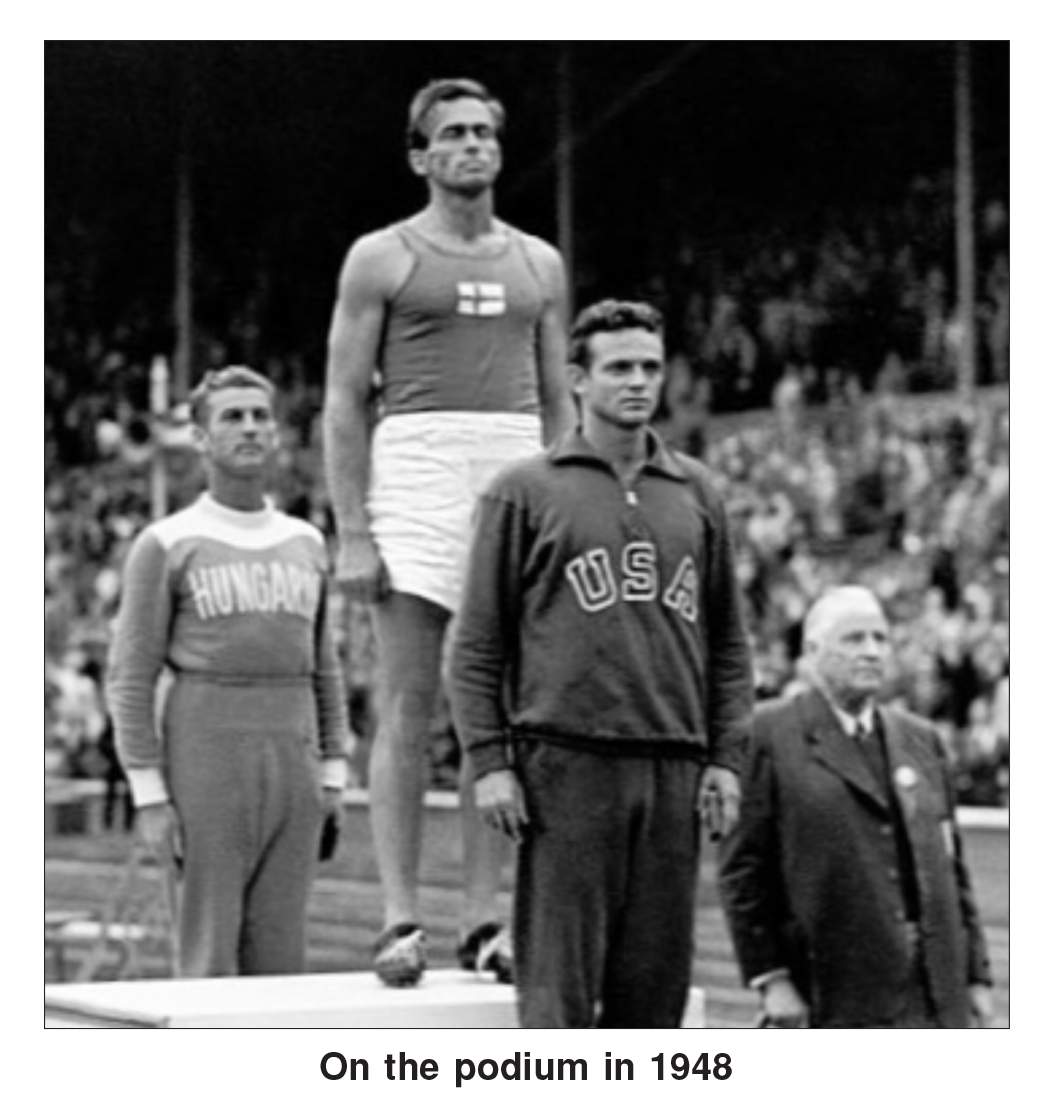
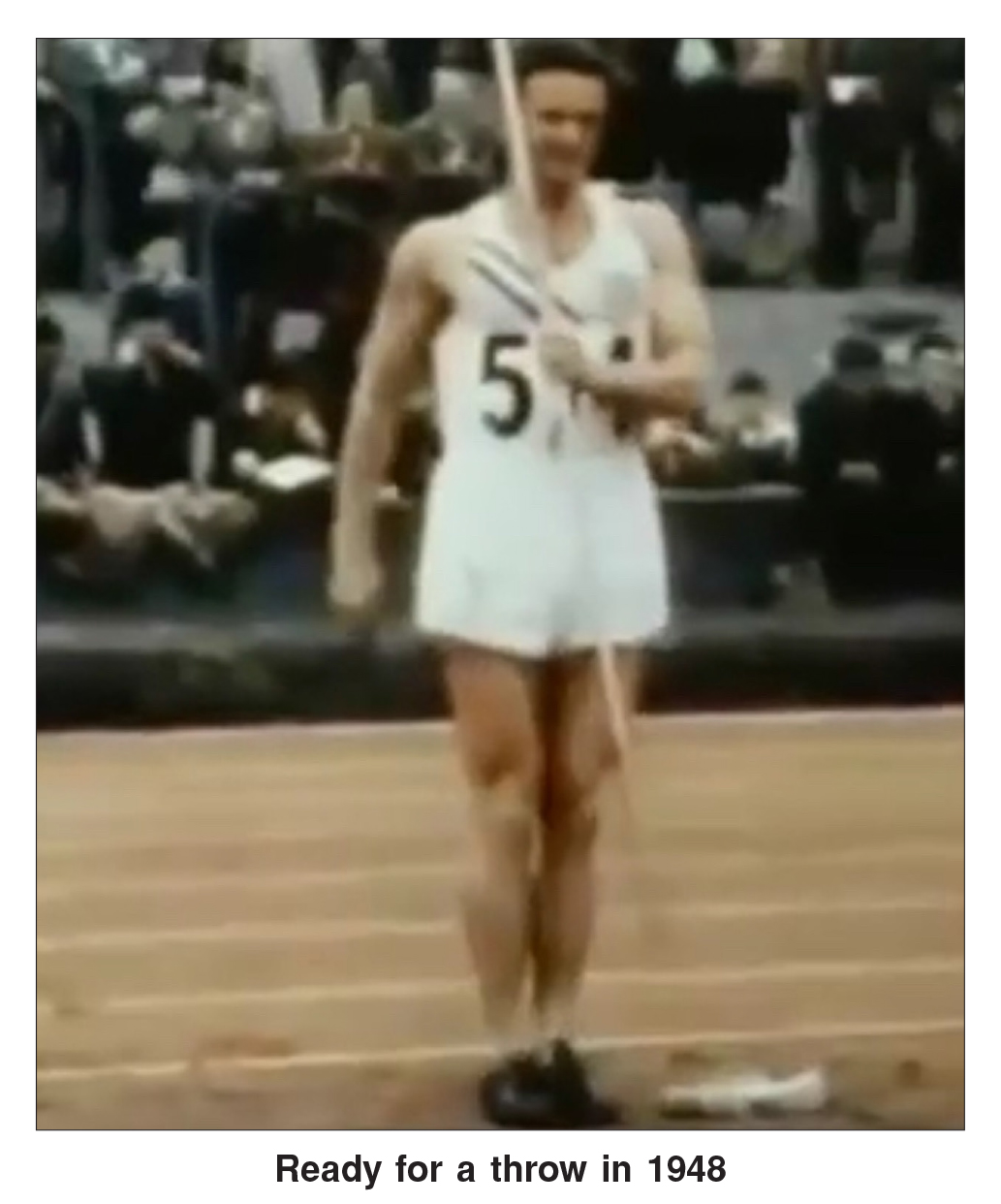
In 1946, he threw 215’ for an Egyptian all-comers record, and shortly thereafter had his right elbow fractured by a mob over there, thinking he and the others were British!! He was treated at Walter Reed, and then at the LA College of Osteopathy, where two
doctors treated him, so he couldregain training in December of the same year.
In 1947, the Times reported that Seymour was at the Helms Athletic Foundation studying Finnish technique….then he went out and broke the AR by more than ten feet, hitting 248’10”. The reporter mentioned the officials took some time to examine Seymour’s javelin and “when they found it wasn’t jet propelled and had no flying saucer for a motor they approved his record.” He won the Helms “Athlete of the Month” for that toss.
In February 1948, Track & Field News ranked him #1 in the world for 1947, based on his AR. Tapic Rautavaara, who later beat him in the Olympics, was ranked 4th with 237’2”. Seymour liked T&FN, and had issues #1 and 2 pasted in his scrapbook.
Track & Field News reported that “he had visited coaches and throwers all over the country trying to pick up fine points of the event. He even talked to baseball greats Bob Feller, Johnny Lindell and Ewell Blackwell seeking the secrets of their powerful arms.” He said there was a lot he didn’t know about the javelin. “I have invented a new style which is not the Finnish or American method, but until I pass 258’ it remains theory.” There was a terrific picture of Blackwell in his scrapbook. It is noted…Blackwell was a wicked sidearm thrower. Perhaps Bob Feller and his fastball would be a better model. Seymour preferred track to other sports because “it is on an individual basis and there are no color or religious lines drawn…a clean cut sport.” This was years prior to the drug era.
Prior to the Olympics, he made a list of his competitors. Next to Y. Nikkanen, Finland, he wrote: “WR holder; leg injury in war; Jarvinen’s protege.” I looked down to this entry: “(X) Mikkola, Finland; died in the war; was #1 prospect for Nikkanen’s world mark.” That made me stop and think for a few minutes. He also wrote Martin Biles’s name down. Biles had beaten him eight times in a row in 1947-48.
In January, 1948, there was an article in the Long Beach Press Telegram that showed Seymour with homemade equipment in his backyard, doing specific exercises for the javelin. He built a horizontal ladder, with varied spacing. He had a javelin attached to a cord, on a pulley, and did javelin motion drills.
Now in the Olympics in 1948, he was behind Biles in the qualifying round. When they entered the final, Biles did not throw well at all. Biles has 67.68 in the qualifying, and only 65.17 in the final, with two throws under 60 meters. Seymour with 63.83 in the qualifying for 5th place, entered the final with a sore elbow, and perhaps a bit of a let down. He fouled his first effort, then only reached 62.56 on his second. Then…along came his friend, Wilbur “Moose” Thompson, the gold medalist in the shot. According to the LA Times, Aug 5, 1948…Moose gave Seymour a good talking to, told him to forget that sore arm. Next throw….67.56, or 221’ 7 1/2” for the US’s first silver medal in the Olympic javelin. (Cy Young and Bill Miller went 1-2 in 1952. Bill Schmidt’s bronze in 1972 has been the only men’s javelin Olympic medal since then.) Thompson’s and Seymour’s families were lifelong friends.
I looked for video of Steve throwing, and did locate two on YouTube. The first one, “Tapio Rautavarra (Finnland) Olympic Javelin Champ 1948” was posted by Gerolf Holkema, true javelin fanatic. There is a clip of Seymour throwing in the Olympics a few minutes in. I sent this link, which is in Finnish, to Stephanie Seymour. She had never seen this before. She had a friend in Finland translate what the very gracious Tapio Rautavarra said about her dad in the video: “There was a guy from California, he was in much better shape than me. He had bad luck. In the London Olympics, the wrong man won the title!” That…is the true Olympic spirit. If you Google Rautavarra, you will learn his amazing story after the Olympics.
The second link was posted by Huntley Film Archives “Javelin Film 317.MPG”. This is a video, mostly of Steve throwing the javelin. There is no origin, but this might have been made by the military. Who else would say: “There are four departments in the javelin?” There are so many shots of Steve throwing bare chested, I was surprised he had a t-shirt on here.
In 1949, he did a talk on the javelin for the National Track Coaches, and it was reprinted in “Clinic Notes”. Thanks to LA84, I was able to get all five pages and it is quite a historic document for the javelin. Seymour had been quoted by Ken Doherty in Modern Track and Field, which led to finding this gem. Other articles available from LA84, were from Bud Held, and two from Frank Metzler, Al Cantello’s coach. The National Track Hall of Fame Library, which Ken Doherty helped established, has vanished, so LA84 still has microfilm of these original pieces.
In 1952, famed sports writer Paul Zimmerman wrote about Bill Miller, silver medalist in the javelin: “He says Steve Seymour taught him what he knows about throwing the spear.” Miller had a PR of 266’ 8 1/2” in 1954. At 5’10”, 170, he was rather small for a thrower. Late in his career, Miller worked with Native Americans and helped bring Jojoba and Guayule to the public eye. He published an article in the National Geographic on his work. Cy Young, at 6’5”, who won the gold in 1952, had a PR of 259’ 8 1/2” in 1956. Young, a walnut/almond farmer, believed he knew more about the javelin that anyone.
Phil Conley, one of the top throwers in the 1950’s and a member of the 1956 Olympic team, thanked Steve with a postcard. In one interview, Conley said: I’m getting more back into the throw now. I’m sure Seymour helped me.” Seymour had a chat with him after a meet, and talked him into revamping his style somewhat.
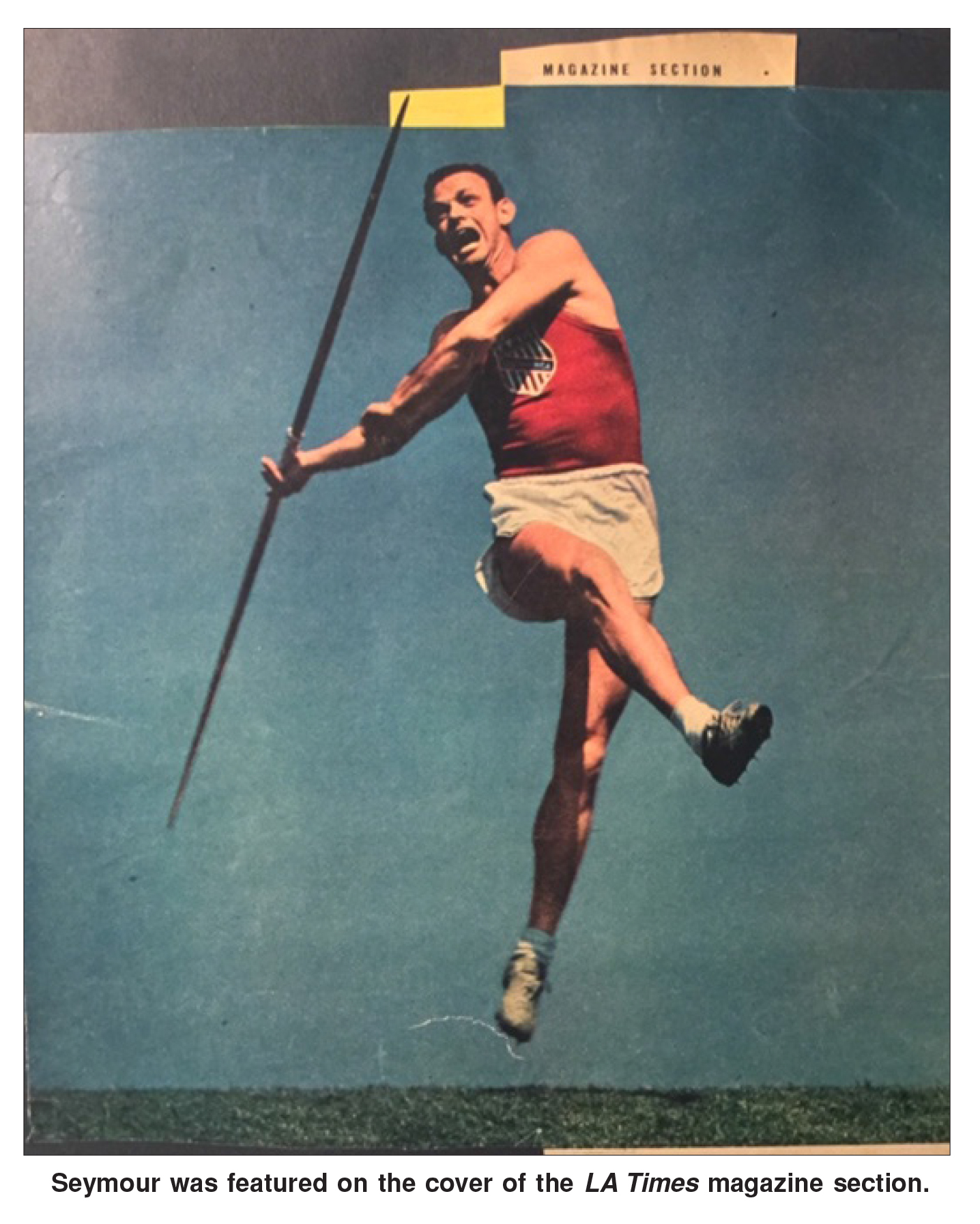 In the early 1950’s, Seymour swam 21 miles in 13:40, after delivering a baby! This was to match the distance of the English Channel swim, in the Pacific Coast Club pool. As he neared the end, he lifted his googles and said “ Well, where’s France?” Stephanie laughed when we found this in the scrapbook.
In the early 1950’s, Seymour swam 21 miles in 13:40, after delivering a baby! This was to match the distance of the English Channel swim, in the Pacific Coast Club pool. As he neared the end, he lifted his googles and said “ Well, where’s France?” Stephanie laughed when we found this in the scrapbook.
In 1952, then Dr. Seymour was in charge of a case involving Dick Doyle, a top U.S. discus thrower, who dove into shallow surf at Seal Beach, and broke his neck. Seymour described the injury as causing almost complete paralysis. Later, the only thing affected was Doyle’s right arm. Doyle’s Montana school record, set in 1951, lasted until 2013. He had thrown 175’6” in the AAU Meet that year.
In 1953, the Held javelin, a hollowed wooden version, was defended by the Karhu manufacturer Rolf Hohentahl. At the time the rules allowed for arbitrary thickness. Cy Young was quoted that Held “used a javelin which floats and travels for at least 20 feet further than the ordinary javelin.” At the time, Bud had thrown 263’ 10”. Matti Jarvinen also agreed with Karhu.
Dink Templeton once wrote a piece for the LA Times entitled “Held’s New Javelin Looks Like Mongoose.” He said the javelin was so fat, it could be mistaken for the carrier Held had which could hold four javelins. He wrote: “When Los Angeles is startled by a horrendous scream of anguish sometime in the near future, don’t be alarmed. It’ll just be Steve Seymour the first time he gets a look at it.” Seymour did try to get the Held javelin banned, along with Cy Young. This surely did not endear him to the Held brothers! It was a time of transition in the javelin, from the hollowed wooden javelins to the upcoming Held aluminum. While researching this, I learned that Bud Held developed the first aluminum tennis and racquetball racquets.
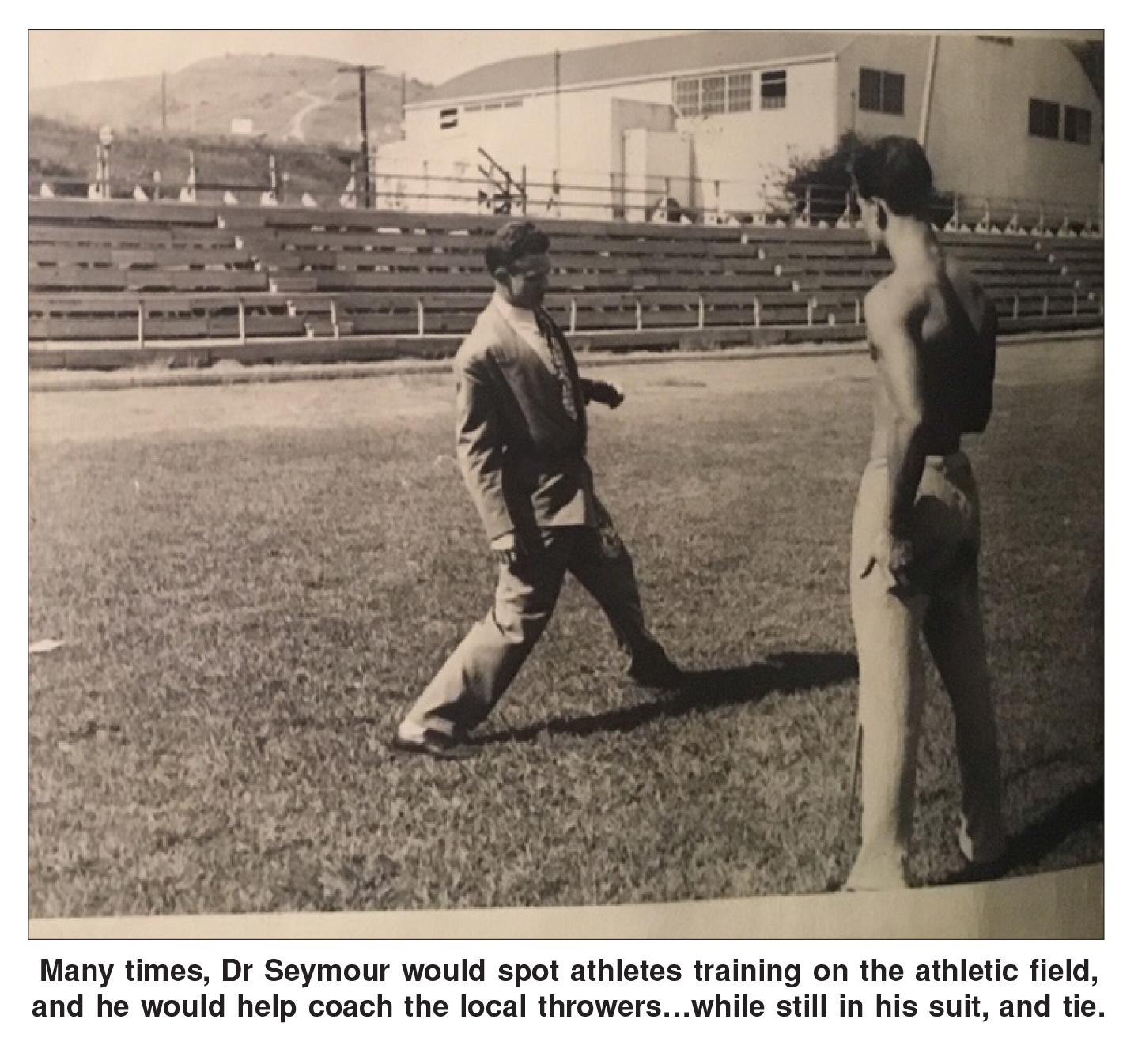 In 1958, Steve Seymour set a PR of 251’1”. It was reported he “employed a unique system of weight exercises, and has steadily improved with age.” Also In the 1950’s, Bert Nelson referred to Seymour: “one of the most amazing and admirable men in our world of track & field. He is a “leader in the treatment of alcoholism, does much to propagandize the sport through writings, speeches, personal appearances, brings an inventive mind to promoting not just the javelin throw but the entire sport.” Nelson reported that Seymour had deadlifted 545 pounds in an event in Long Beach, matching Dave Davis, the shot-putter. Seymour told Nelson the flat beach at low tide “may be the fastest running surface known to man.” Seymour had a race with 140 competitors on the beach, and 9,000 spectators watched!
In 1958, Steve Seymour set a PR of 251’1”. It was reported he “employed a unique system of weight exercises, and has steadily improved with age.” Also In the 1950’s, Bert Nelson referred to Seymour: “one of the most amazing and admirable men in our world of track & field. He is a “leader in the treatment of alcoholism, does much to propagandize the sport through writings, speeches, personal appearances, brings an inventive mind to promoting not just the javelin throw but the entire sport.” Nelson reported that Seymour had deadlifted 545 pounds in an event in Long Beach, matching Dave Davis, the shot-putter. Seymour told Nelson the flat beach at low tide “may be the fastest running surface known to man.” Seymour had a race with 140 competitors on the beach, and 9,000 spectators watched!
In 1957, he found himself 30 lbs overweight. So he went on a diet, lost 30 lbs and 7” off his waist, trained and wound up throwing 248’10” which equaled his AR from 10 years earlier. The diet: Breakfast – juice, bran flakes, coffee; Lunch – Salad, fruit, all you want; Dinner – meat and vegetables. The article was entitled: “ I came back from ‘early old age’”. He was working many hours as an osteopath, and also with his clinic for alcoholism.
He was featured in the “Mirror News” in March 1959: “Never too old: After a day in clinic, Dr. Steve Seymour lifts weights in his Long Beach apartment, then goes for a romp in the surf, followed by javelin practice on the sand.” He made a comment that he was experimenting with lifting weights while in the “different positions you would assume while throwing. Then you lift weights in these various positions. I’m very excited about it, and think with this program, a man will be able to throw 300 feet.” He was 38 and had his sights on the 1960 Olympics. A Strength & Health editor must have seen this, and asked Hal Higdon to write an article on the “innovations”. Unfortunately, I have not found this article as of this date.
Seymour said, “I think I’ve read everything that’s ever been written on the javelin. I had all the foreign books translated and even communicated by ham radio with the European experts.” He knew the javelin! “The right elbow, then the right arm, then the right hand…the right wrist…and a powerful flip” he typed in a note on throwing. Seymour put the caps in: “Dean (Cromwell) says the back should be bowed…the Finns throw with half a chest as the outfielder…I thrust the spear with the whole chest…the body moves ahead of the spear…the arm hangs behind below… [Matti] Jarvinen is bouncy…I have translated all his stuff besides working out with him…and Valste, who has learned from Jarvinen…THEIR ELBOW IS WIDE…AND AS VALSTE SAYS ALL JAVELIN THROWERS HAVE ARM TROUBLE. THIS SHOULD NOT BE…” Seymour knew what muscles were used…and wrote notes on that for a presentation.
Another note discussed his displeasure with the Finnish method: “I worked with Jarvinen, Nikkannen, the WR holder…and Valste, the head Finnish coach who is dogmatic in training methods. I threw 225’ using this style and after a few weeks of personalized coaching was up to 210’ using his methods. After my return to the US…using this low draw-back…I was down to 200’. One day, Dean Cromwell was watching me louse up my distance and he asked me if I had enough of the Finnish style. My answer was…more than enough. My coach back East who is assisting [Ken] Doherty at Penn, Bob Detweiler, was also happy I was discarding this style. It is a side-arm style.” Again, he mentioned Cromwell, Detweiler, Comstock and Templeton, praising all for their contributions to his understanding of the javelin.
Maxwell Stiles, writing on the Compton Relays, told a story of how Held’s javelins could be blown off course. Cy Young had a throw blown “60-70’ off line.” It missed his wife Bonnie by two feet, in the stands!! Seymour gave four points on what a “spearman” must consider, and the fourth was “Did I run it through someone?” In 1960, in an exhibition at an All Comers at Wilson HS, he threw 237’2”. At the time he was 40 years of age.
In 1961 Seymour was the co-ordinating Project Director for a report to President Kennedy, called “The Soft American: Problems and Solutions.” There were 105 people interviewed, among them famous actors, coaches, police, etc. The longest report was written by Bert Nelson, co-founder of Track & Field News. Pat Boone, Jerry West, Elgin Baylor, and Otis Chandler were among those interviewed. It is a fascinating report, just as accurate today in its assessments, as it was then. Parry O’Brien: “Automation is responsible. In European countries, people walk 2-3 miles to work. This contributes to physical and moral hardness.” Arnold Palmer: “Exercises are not enough. We need youth programs to expose kids to activity and they will begin to like it.”
In 1965 Seymour arranged to put on a 24-hour race at the indoor Los Angeles Athletic Club. It was called the “24-Hour Last Day Run”. It was believed at the time the first modern-day American 24-hour race. Steve ran in it also, and did 50 miles in 17.5 hours! It was called “Last Day” as it was run on October 31, to help the running club pile up mileage. At one point, he set a record for a man weighing 215 lbs or more, with 57 miles on the LAAC track. Someone calculated it as 627 laps, if it was eleven laps per mile.
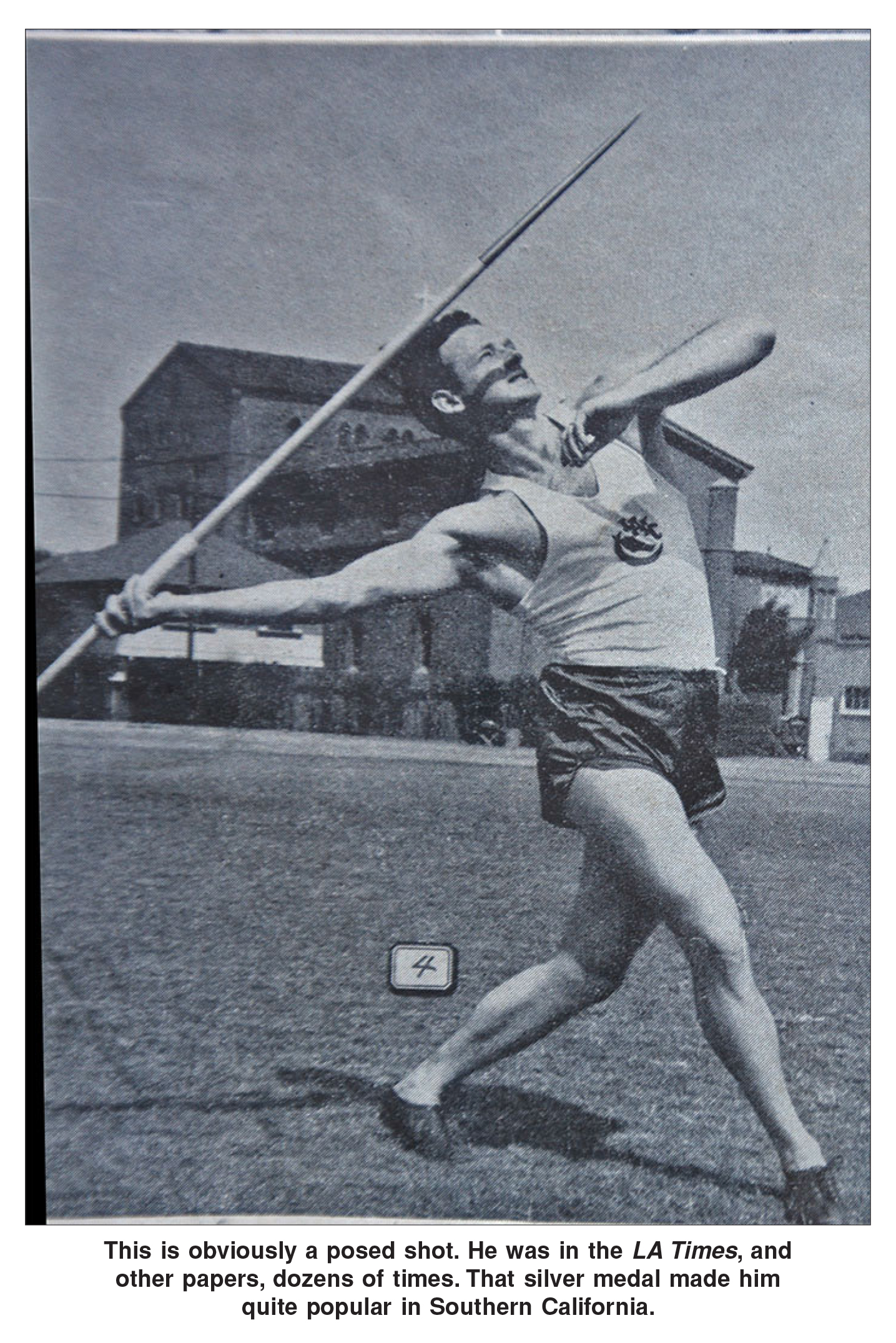 He wrote a piece for Amateur Athlete entitled, “Let’s Bring the Javelin Back.” In it he described the javelin he threw in 1959, as a “double weight”, 3.5 pounds. He felt that the 800 gram javelin was too light. Coach Chuck Coker told him once: “The heavy javelin separates the men from the boys.”
He wrote a piece for Amateur Athlete entitled, “Let’s Bring the Javelin Back.” In it he described the javelin he threw in 1959, as a “double weight”, 3.5 pounds. He felt that the 800 gram javelin was too light. Coach Chuck Coker told him once: “The heavy javelin separates the men from the boys.”
He hobnobbed with some famous people, like Jayne Mansfield and Mickey Hargitay. If you watch “Law and Order”, then you know the star is their daughter. He won the 1971 U.S. Masters All Around Athlete and Outstanding Athlete Award. In an article on him, he was quoted: “Personally, it is a genuine thrill to have a major athletic challenge after you’ve reached your 50th year.”
He wrote a book, “How to Improve Your Thinking to Solve Your Problems.” It is a rather interesting collection of 300 rules and ideas on how to think and communicate. In the Preface, he wrote “This is the first textbook ever written by a practicing physician on the art of logical thinking and its crucial relationship to mental health.”
Remember how I started this piece with the Sports Illustrated quote? There was more to it, as I found when I downloaded the article.
“The javelin is as old as gladiators and also as modern as Cape Kennedy. The human body is the launching pad and booster and all that, and only the rocket has changed over the years. The inspiration to send the rocket skyward—even that’s still the same. And the javelin remains the last line of defense. Think of Janis Lusis and Mark Murro. Now [in 1969] they throw in the same direction. After destruction of an atomic war, just picture the two of them facing each other, two men along on the field of battle, the ultimate confrontation.”
As I come to the end of this article, I achieved what I wanted to do— learn about Steve Seymour.
Let’s celebrate America’s first silver medalist in the Olympic javelin. I’ve been pleased to assemble this story, and it is inspiring to know that while Steve Seymour was an Olympian, he was much more. He was a terrific dad to his three kids. Can you imagine throwing a javelin with your dad at the beach?? When he struggled the last few years, he never let his kids know, even though they were adults.
Here was a guy who not only treated many thousands of patients as an Osteopathic Physician, he helped a large number of alcoholics in his clinic. Journalist Walter Winchell singled this out for praise in September, 1962. Seymour helped coach several top U.S. stars. I just learned earlier this week, that he coached Earlene Brown, the woman shot putter who competed in three Olympics. Earlene was a real pioneer in the women’s shot in the USA.
He was President of the American Academy of Achievement and directed communication seminars among Nobel Prize winners. As the director of the Los Angeles Fitness Council, he prepared the “Soft American” report for President Kennedy. He worked with unemployed youth in Long Beach. Seymour also founded the Seymour Hospital and Medical Clinic. He also worked with the then governor Goodwin Knight on conferences discussing serious heath problems facing California. He lectured and taught at the Loma Linda Medical School, and did studies at San Quentin, Chino, Terminal Island while conducting courses for correction officers. His whole life was devoted to fighting against alcoholism and narcotics addition.
As someone who translated Egil Danielsen’s book at age 16, (and I will note, Egil, the 1956 Olympic champion, passed away recently), I can definitely relate to America’s first true javelin aficionado…Steve Seymour. He passed on his knowledge to many others. Imagine recovering from a fractured elbow, and then get the silver medal two years later.
Tomorrow, I plan on having a bowl of Kellogg’s All-Bran, and will lift my coffee cup to honor the memory of this unique American athlete, Steve Seymour.
Kevin McGill has coached at various levels in track & field—high school, college and national teams. He is a USATF Level I and II instructor, and in addition to his contributions to the books The Throws Manual and to Track & Field Omnibook has published in various journals in the sport. He is a former editor of Track Coach.
